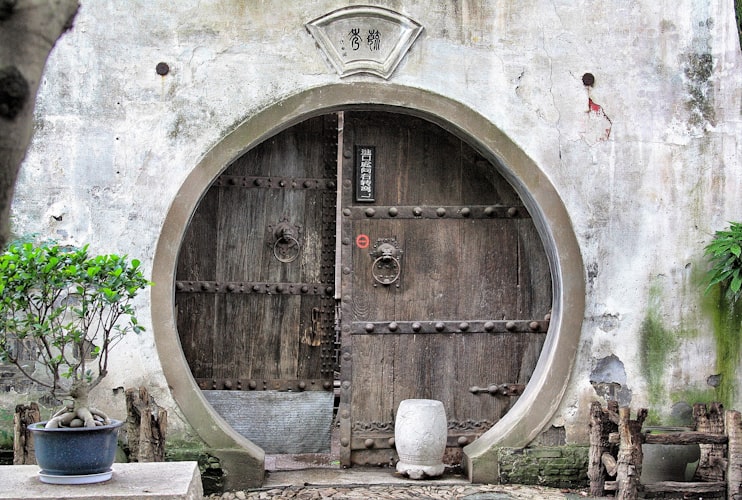
#UCDAssemble Workshop Covering Genome Assembly
Readers interested in sequence assembly may take a look at the tweets under hashtag #UCDAssemble. It is attended by a number of researchers, who are working on writing genome assembly programs or are heavy users of such programs (e.g. Jared Simpson, Jason Chin, Titus Brown, Lex Nederbragt, Nick Loman). The workshop is technically-oriented with a number of hands on exercises. We will summarize the key points for those without twitter access.
Conference-related documents are available here.
-————————————
How to Pronounce de Bruijn?
The conference started with answering the most pressing issue of the day - saying de Bruijn correctly. Following twitter comments have the answer:
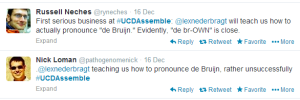
There is also a Biostar thread on the same topic.
-————————————–
Quality Assessment and Adapter Trimming
Jared Simpson discussed his preqc software for quality check before genome assembly. We covered it a few months back.
Nick Loman pointed out about the importance of adapter-trimming. His blog post on this topic is linked below.
Adaptor trim or die: Experiences with Nextera libraries
Other programs mentioned in the same context -
Kraken for discovering adaptor sequences de novo
Coral: an error correction algorithm for reads from platforms such as the Illumina or Roche/454
-—————————————
Kitomics from Nick Loman
Nick Loman pointed out that the kits themselves can be contaminated and need to be sequenced before actual sample.
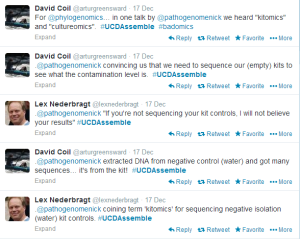
-————————————–
PacBio Makes a Big Stir
The workshop organizers arranged a number of talks on PacBio and they seemed to have left a positive impression on the technology.
Shane Brubaker:
Following tweets cover his presentation.
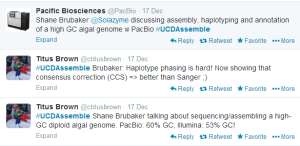
“Brubaker: Haplotyping algorithm available for PacBio #UCDAssemble” Link
Jason Chin:
Jason Chin presented on diploid assembly. He made his slides available.
Lex Nederbragt:
Lex Nederbragt presented on the cod assembly.
** Improving and validating the Atlantic Cod genome assembly using PacBio ** from Lex Nederbragt
Lawrence Hon:
We did not see too many tweets and presume he presented on how to assemble using HGAP. Title of talk - “Larger genome hybrid assembly with PacBio.
Brett Bowman:
Presented on a metagenome data set that PacBio releases for public consumption. Relevant tweets are below.
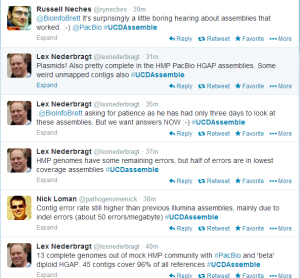
The biggest hit appears to be string-graph visualization software from @infoecho (Jason Chin).
Too many Programs, Too Little Benchmarking
Lex Nederbragt pointed out the biggest difficulty faced by bioinformaticians today. It is not abundance of data or lack of computers, but publication of too many programs, each claiming to be doing better than others. Someone needs to rescue bioinformatics world from Lake Wobegon, where “all the children are above average”, and that means the dirty work of benchmarking !
Blobology
Attendees discussed Sujai Kumar’s Blobology approach. Those unfamiliar with the word can check his recent paper and get started.
Generating the raw data for a de novo genome assembly project for a target eukaryotic species is relatively easy. This democratization of access to large-scale data has allowed many research teams to plan to assemble the genomes of non-model organisms. These new genome targets are very different from the traditional, inbred, laboratory-reared model organisms. They are often small, and cannot be isolated free of their environment whether ingested food, the surrounding host organism of parasites, or commensal and symbiotic organisms attached to or within the individuals sampled. Preparation of pure DNA originating from a single species can be technically impossible, but assembly of mixed-organism DNA can be difficult, as most genome assemblers perform poorly when faced with multiple genomes in different stoichiometries. This class of problem is common in metagenomic datasets that deliberately try to capture all the genomes present in an environment, but replicon assembly is not often the goal of such programs. Here we present an approach to extracting, from mixed DNA sequence data, subsets that correspond to single species genomes and thus improving genome assembly. We use both numerical (proportion of GC bases and read coverage) and biological (best-matching sequence in annotated databases) indicators to aid partitioning of draft assembly contigs, and the reads that contribute to those contigs, into distinct bins that can then be subjected to rigorous, optimized assembly, through the use of taxon-annotated GC-coverage plots (TAGC plots). We also present Blobsplorer, a tool that aids exploration and selection of subsets from TAGC-annotated data. Partitioning the data in this way can rescue poorly assembled genomes, and reveal unexpected symbionts and commensals in eukaryotic genome projects. The TAGC plot pipeline script is available from https://github.com/blaxterlab/blobology, and the Blobsplorer tool from https://github.com/mojones/Blobsplorer.